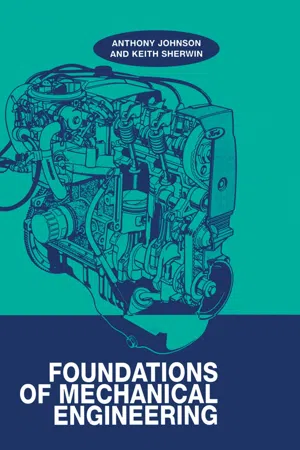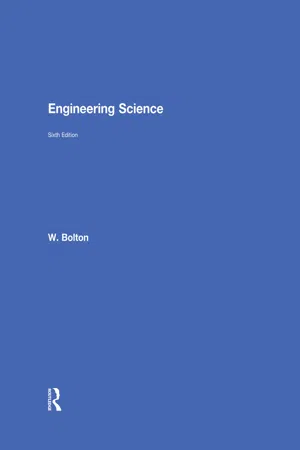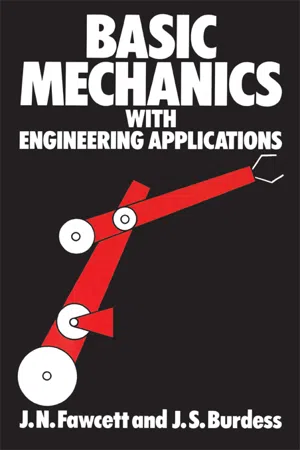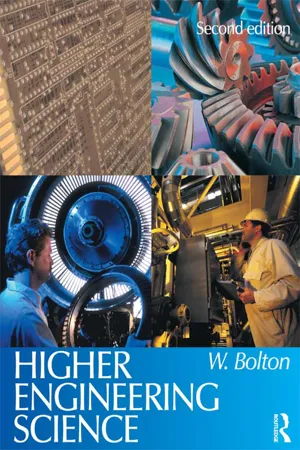Technology & Engineering
Power in Mechanics
Power in mechanics refers to the rate at which work is done or energy is transferred. It is a measure of how quickly a force can do work. In the context of technology and engineering, power is a crucial concept for understanding the performance of machines and systems, as well as for designing and optimizing their efficiency.
Written by Perlego with AI-assistance
Related key terms
5 Key excerpts on "Power in Mechanics"
- eBook - ePub
- A. D. Johnson(Author)
- 2017(Publication Date)
- CRC Press(Publisher)
When describing the energy output of, say, an internal combustion engine or a turbine, the word ‘power’ is often loosely applied. It may be said that the engine is ‘powerful’, but this refers to mechanical output power.The term ‘power’ may be considered in a number of different ways and depends upon how the power is generated, stored and used. For instance, chemical ‘power’ is stored as petrol and is released when petrol is burned. The rate of heat generated may be measured in watts (the unit of power). Petrol, of course, is burned in an internal combustion engine, which has a mechanical output power, also measured in watts.Electricity is generated by forcing high-temperature steam through a turbine. The ‘power’ possessed by the steam turns the turbine which, in turn, drives the generator, thus producing the electricity. This can also be measured in watts. The electrical power can be used to turn an electric motor which converts it back into mechanical power.Whatever the means of conversion or generation, the power developed is measured in watts, and if losses are ignored, the power possessed by one medium can be converted to, and used in, another medium.Power is the rate of doing work. The base unit of power is the joule/s, designated J/s, and, in mechanical terms, can be defined by considering: 1 N moved through 1 m in 1 s, so that the unit of power is J/s = W .This can be explored further by considering equation (5.1) :w = F × sDividing both sides by time givesbutw t= F ×s t ( 5.13 )ands t= velocity, υw t= power, Pso that equation (5.13) can be rewritten:Convention dictates that the unit of J/s is redesignated as the watt or W. The watt is often found to be too small to be used effectively and so other derivatives are used such as:w = F × vJ / sor W ( 5.14 )Often the amount of power used is measured for a period of time. For instance, domestic electricity is measured in kilowatt-hours.kilowatt = 1000 Wmegawatt = 1 000 000 W - eBook - ePub
- W. Bolton(Author)
- 2015(Publication Date)
- Routledge(Publisher)
Chapter 24 Mechanical power transmission24.1 Introduction
This chapter is an introduction to the basic principles of simple machines and mechanical power transmission with a discussion of machines such as levers, pulleys, gears, etc. A machine is defined as a mechanical device which enables an effort force to be magnified or reduced or applied in a more convenient line of action, or the displacement of the point of action of a force to be magnified or reduced.24.1.1 Basic terms
The term effort is used for the input force, the term load for the output force. The force ratio or mechanical advantage MA is defined as:The movement ratio or velocity ratio VR is defined as:For an ideal machine where there are no frictional forces, mechanical energy is conserved and so the work done by the effort must equal the work done by the load:effort X distance moved by effort = load X distance moved by load Rearranging this gives:For a non- ideal machine there are some energy losses due to friction. The efficiency of a machine may be defined as a fraction by:i.e. the useful energy output/(energy input). Thus: If we consider the energy input and output per second, i.e. the powers, then we can also write: The above definitions give the efficiency as a fraction. It is, however, often written as a percentage; this just involves multiplying the fraction by 100.Example A machine is able to lift a mass of 50 kg through a vertical height of 5 m when it is supplied with an energy input of 4000 J. What is the efficiency of the machine? The useful energy output from the machine results in a gain in potential energy mgh = 50 X 9.8 X 5 = 2450 J. Thus the efficiency, expressed as a percentage, is (2450/4000) X 100 = 61.25%.Example The input power to a machine is 75 kW and the output power is 60 kW. What is its efficiency? Efficiency 5 (60/75) X 100 = 80%24.2 Law of machines
The mechanical advantage of a machine depends on the effort applied. For simple machines, the relationship between the effort E and load F is of the form (Figure 24.1 - eBook - ePub
- Hani M. Tawancy, Anwar Ul-Hamid, Nureddin M. Abbas(Authors)
- 2004(Publication Date)
- CRC Press(Publisher)
A derived concept closely related to force is that of work. When a body is displaced a distance L along the direction of an applied force F, the product of force and displacement is called work. If the force F remains constant during the displacement L, the work W is given byEnergy can take several forms including kinetic and potential energy. Kinetic energy (KE) is energy acquired by motion, which is defined by the relationshipMechanical work as defined by the above equation is a technical term related to a derived concept of mechanics called energy. By definition, energy E is the capacity of a body to do work. It has the same units as work, i.e., energy is the product of force and length.PE = mgLwhere m is the mass of a moving body and v is the magnitude of its velocity. Energy stored in a body because of its position is called potential energy (PE) and is defined bywhere m is the mass of the body, g is the acceleration of gravity, and L is the elevation of the body with respect to some reference level.Generally, only changes in energy can be calculated; i.e., it is not possible to evaluate absolute energy values. However, it turns out that only changes in energy are of significance rather than absolute values of energy.3.5 Force and Motion
A force can produce two types of motion: (i) translational and (ii) rotational. During translational motion, all straight lines prescribed within the body remain parallel. When a body is in a state of rotational motion, every point within the body revolves in a circular path about some point not necessarily in the body, which serves as the axis of rotation.In terms of motion, if several forces are simultaneously acting on a body, they can either be concurrent or nonconcurrent. By definition, concurrent forces, which produce translational motion, act on the same point of a body. An equivalent statement is that the lines of action of concurrent forces intersect at a common point, as shown in Fig. 3.2a. Conversely, nonconcurrent forces (Fig. 3.2b), whose lines of action do not intersect at a common point, can produce rotational motion. For example, consider a body that has an axis of rotation such as the axle of a wheel. A force F - eBook - ePub
- J Jones, J Burdess, J Fawcett(Authors)
- 2012(Publication Date)
- Routledge(Publisher)
power of the system which is applying the force. For example, the power of an engine is the rate at which the engine can do work on another system.The units of power are Js−1 , Nms−1 or in fundamental units, kgm2 s−3 . Power is often quoted in Watts (W) so that 1W = 1 Js−1 = 1 Nms−1 = 1 kgm2 s−3 .Using eqn (5.21) power may also be expressed asThe term δr/δt is the magnitude of the velocity vector ν of the point of application of the force.in which θ can be interpreted as the angle between the force vector F and the velocity vector ν of the point of application of the force, as shown in Fig. 5.16 .FIG . 5.16When F and ν are given in terms of their components Fx , Fy and νx , νy eqn (5.3) shows that the power P can also be written in the formSimilarly if the point of application of the force moves with ν = ds/dt along a curve C as shown in Fig. 5.17 then eqn (5.8) gives the power P asFIG . 5.17The power is therefore determined by the tangential component of the force Ft , and the velocity ν of the point of application of the force along its curve.From example 5.2 the work δW done by a moment, or torque, M can be written asThe rate at which work is done by the moment is thereforeFor example, in a case where the moment M is applied to the end of a shaft, will be the angular velocity of the shaft.Example 5.4 Figure 5.18(a) shows the torque characteristic of a motor in which the torque M varies with its rotational speed ω such thatLet us find how the power output of the motor varies with speed. From eqn (5.27)FIG . 5.18The speed at which maximum power is developed can be obtained by differentiating eqn (ii) with respect to ω and equating the result to zero, i.e.Thus, at maximum power,The graph of P against ω is as shown in Fig. 5.18(b) .When a motor with such a torque characteristic is used to drive a steady load, the size of the motor can be minimised by ensuring that the motor runs at a speed of ω0 /2 i.e. at its maximum power condition. If the required steady angular velocity ωL of the load is different from ω0 /2 it would be desirable to connect the motor and load together via a gearbox with speed ratio ω0 /2:ωL - eBook - ePub
- William Bolton(Author)
- 2012(Publication Date)
- Routledge(Publisher)
5 Energy transfer5.1 IntroductionThis chapter is concerned with the energy transfers that can occur with mechanical systems. Energy can be transferred from one form to another by work being done or by heat transfer. Here we restrict the discussion to transfers involving work. There are many forms that energy can take and in this chapter potential energy, linear and angular kinetic energy and strain energy are discussed and the principles applied to the solution of mechanical system problems.5.1.1 Conservation of energyThere is a basic principle that is used in all discussions of energy and that is that energy is never lost, it is only transformed from one form to another or transferred from one object to another. This is the principle of the conservation of energy. In any process we never increase the total amount of energy, all we do is transform it from one form to another.5.2 WorkThe principle of the conservation of energy is that energy is never created or lost but only converted from one form to another. In all such conversions, the total amount of energy remains constant.Work is said to be done when the energy transfer takes place as a result of a force pushing something through a distance (Figure 5.1 ), the amount of energy transferred W being the product of the force F and the displacement s of the point of application of the force in the direction of the force.Figure 5.1 WorkWith force in newtons and distance in metres, the unit of work is the joule (J) with 1 J being 1 N m.Work done by a constant force W = Fs [1] Consider the work done by a force F when the resulting displacement s is at some angle 0 to the force (Figure 5.2 ). We can look at this in two equivalent ways. We can consider the displacement in the direction of the force F is s cos θ and so the work done is:work done = F × s cos θ [2] Figure 5.2 An oblique forceAlternatively, we can consider the force component acting in the direction of the displacement. The force can be resolved into two components, namely F cos θ in the direction of the displacement and F sin θ at right angles to it. There is no displacement in the direction of the F sin θ component and so it does no work. Hence the work done by the oblique force is solely due to the F cos θ
Index pages curate the most relevant extracts from our library of academic textbooks. They’ve been created using an in-house natural language model (NLM), each adding context and meaning to key research topics.




